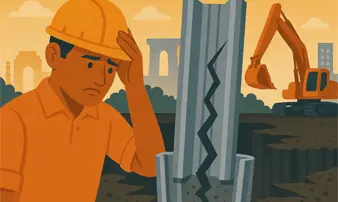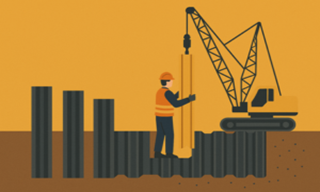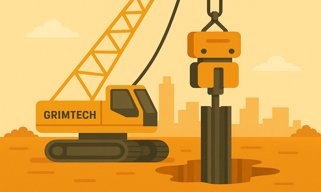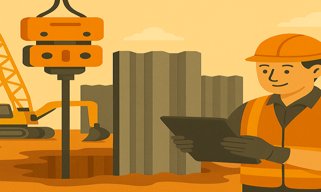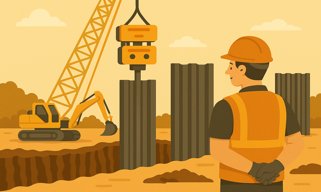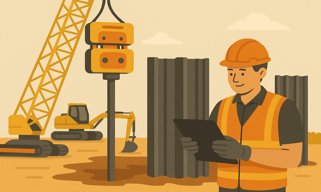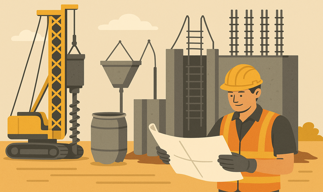Common Mistakes in Piling Work in India and How to Avoid Them
It is the secret of the Indian building scene that people do pile work. It keeps buildings, towers, and bridges in place no matter what. It digs deep to find stable ground, even in rough mountain terrain or on Goa’s wet coast. Mess it up, and you’re staring at tilting structures, missed deadlines, and wallets running dry. India’s chaotic soils—mushy riverbeds, rocky outcrops, and clay that shifts with the seasons—make piling work in India a tough gig. Here, we unpack six big blunders that can derail projects and toss out no-nonsense tips to keep your foundations tight.
-
Skimping on Soil Homework
Building without knowing your dirt is like sailing without a map. India’s ground is a wild mix—silty slop in Kerala, granite chunks in Karnataka, clay that swells in Madhya Pradesh. Cutting corners on soil tests is a risky bet. Guess wrong about how soil holds or settles, and your piles might give way, leaving buildings cracked or leaning. For example, missing how clay shrinks under load can haunt you with structural splits years later. Solid soil studies are the starting block for piling work in India, and half-doing them invites chaos.
Fix It: Go hard on soil tests—drill boreholes, run SPT, and pull CPT data. Rope in geotech pros to break down what’s what. Spending a month and some cash now beats coughing up crores to fix a sinking tower. A good survey paints a clear picture of the subsurface, so piles hit the right depth and grip firm. Don’t let tight schedules push you to skip this; it’s the root of a strong foundation.
-
Half-Baked Pile Plans
A shaky pile design is trouble waiting to strike. Some folks churn out lazy blueprints that ignore local quirks, like quakes in Uttarakhand or coastal blasts in Andhra Pradesh. Skip how soil and piles mesh or miss seismic risks, and you’re stuck with anchors that wobble or bust. India’s jumbled geology means generic plans flop—custom designs are a must for piling work in India to stand tall.
Fix It: Hire engineers who live for piling. Map loads dead-on using software and stick to IS 2911 criteria. Keep your plans flexible and ready to change should the site cough out surprises like soft areas or concealed rock. Walking the site during planning helps identify early red flags, so piles are constructed for the actual use rather than as a desk dream. Maintaining active involvement grounds designs in reality.
-
Wrong Piling Play
Not every piling method fits every spot. Driven piles rock in tough soils but can rattle old Chennai streets, cracking shops next door. Bored piles tank in Guwahati’s soggy ground without ironclad casing. Pick the wrong play, and you’re hit with delays, ballooning bills, and cranky clients. India’s packed cities and wet zones make method choice a make-or-break call in piling work in India.
Fix It: Match the piling trick to the dirt, job size, and neighborhood vibe. Early on, sit down with contractors to hammer the optimum fit—bored piles for urban projects to reduce noise, driven for open locations with hard ground. Look for cover from headaches among the surrounding buildings and ground. Beef up casing in moist areas to maintain bores constant. Thinking it through upfront saves time and keeps everyone cool.
-
Cheap Gear
Using cut-rate concrete or flimsy steel is a trap. Shoddy stuff falls apart fast, especially in Mumbai’s salty tides, where rust munches weak rebar like candy. Saving pennies now means piles that crumble, dragging your project down with them. For piling work in India to last a lifetime, quality clothing like Grimtech knows top-shelly materials are non-negotiable.
Fix It: Purchase from vendors who meet IS criteria—IS 456 for concrete, IS 1786 for steel. Test every batch: tensile pulls for rebar, slump tests for concrete. To combat chemical wear in salt or acidic environments, use sulfate-resistant cement or corrosion-proof steel. Don’t allow budget cuts push you toward trash; a collapsed foundation costs far more than decent materials ever will. Quality tools are those that last.
-
Loose Oversight
Nobody minding the shop? That’s a fast track to flops. Rookie bosses might miss wonky piles or sloppy concrete pours. Botch the pile depth—too short or absurdly deep—and your loads won’t hold up. In India’s high-octane city builds, like Pune’s IT sprawl, slack supervision leaves foundations shaky. Sharp eyes are the glue for piling work in India to run smooth.
Fix It: Put battle-tested supervisors in charge, not greenhorns cutting their teeth. Roll out clear checklists for every step—drilling, rebar, pouring. Run pile integrity tests (PIT) after to catch cracks or voids. Daily walk-throughs and tight logs keep the crew honest. A hawk-eyed lead spots screw-ups before they morph into structural disasters, saving cash and stress.
-
Ignoring Water Woes
High groundwater in places like Kolkata or Tamil Nadu can swamp your piling game. Weak dewatering or flimsy casing lets bores cave or concrete turn to slush. Blow off water’s chemical bite—sulfates or salts—and your piles will rot away. Taming water is a big piece of piling work in India, especially in rainy or coastal spots.
Fix It: Set up serious dewatering with wellpoints or deep wells to keep water out. In soggy zones, pour concrete with tremie pipes to keep it clean and strong. Test water for troublemakers and use sulfate-resistant cement in rough spots. Map out monsoon risks and groundwater levels early to keep piles tough. Planning for water keeps your anchors solid for the long haul.
Conclusion
From bustling metropolitan centers to quiet rural roads, piling is the grunt job supporting India’s larger goals. But mistakes—lazy soil checks, poor plans, or neglected water problems—can convert a close work to ruin. Builders can avoid these traps by delving deeply on prep, maintaining quality, and closely monitoring. Nailing piling work in India involves creating anchors that laugh off time, storms, and strain, crafting a future as hard as the ground under.
FAQ :
1. Why is soil testing so important before piling work in India?
Soil testing is crucial because India’s terrain varies dramatically—from clay-heavy Madhya Pradesh to silty Kerala and rocky Karnataka. Without proper geotechnical surveys, piles may settle unevenly or fail altogether, leading to structural cracks and safety issues. Comprehensive tests like SPT, CPT, and borehole drilling help ensure the piles reach stable strata for long-term strength.
2. What are the risks of using low-quality materials in piling foundations?
Using substandard concrete or steel compromises the entire foundation. In coastal areas like Mumbai or Chennai, poor-quality materials corrode quickly due to salt exposure. This leads to premature pile failure, structural damage, and increased repair costs. Always use IS-standard materials and conduct batch testing to maintain safety and durability.
3. How do I choose the right piling method for my project in India?
The best piling method depends on soil conditions, project size, and the local environment. For example, bored piles work well in crowded urban areas like Delhi to reduce noise, while driven piles suit open sites with dense soil. Consulting with experts early helps match the right method, saving time, cost, and avoiding neighborhood disruptions.
4. What kind of supervision is needed during piling construction?
Strong on-site supervision is non-negotiable in piling work. Experienced supervisors can identify incorrect depths, improper concrete pours, or rebar issues early. Using daily checklists, pile integrity tests, and strict documentation ensures quality control and prevents costly structural problems down the line.
5. How can groundwater affect piling performance in Indian projects?
High groundwater levels, common in cities like Kolkata and Chennai, can collapse boreholes or weaken poured concrete. Without proper dewatering or chemical-resistant materials, piles may corrode or fail. It’s essential to plan groundwater management—like wellpoint systems—and use sulfate-resistant cement in aggressive soil zones.

